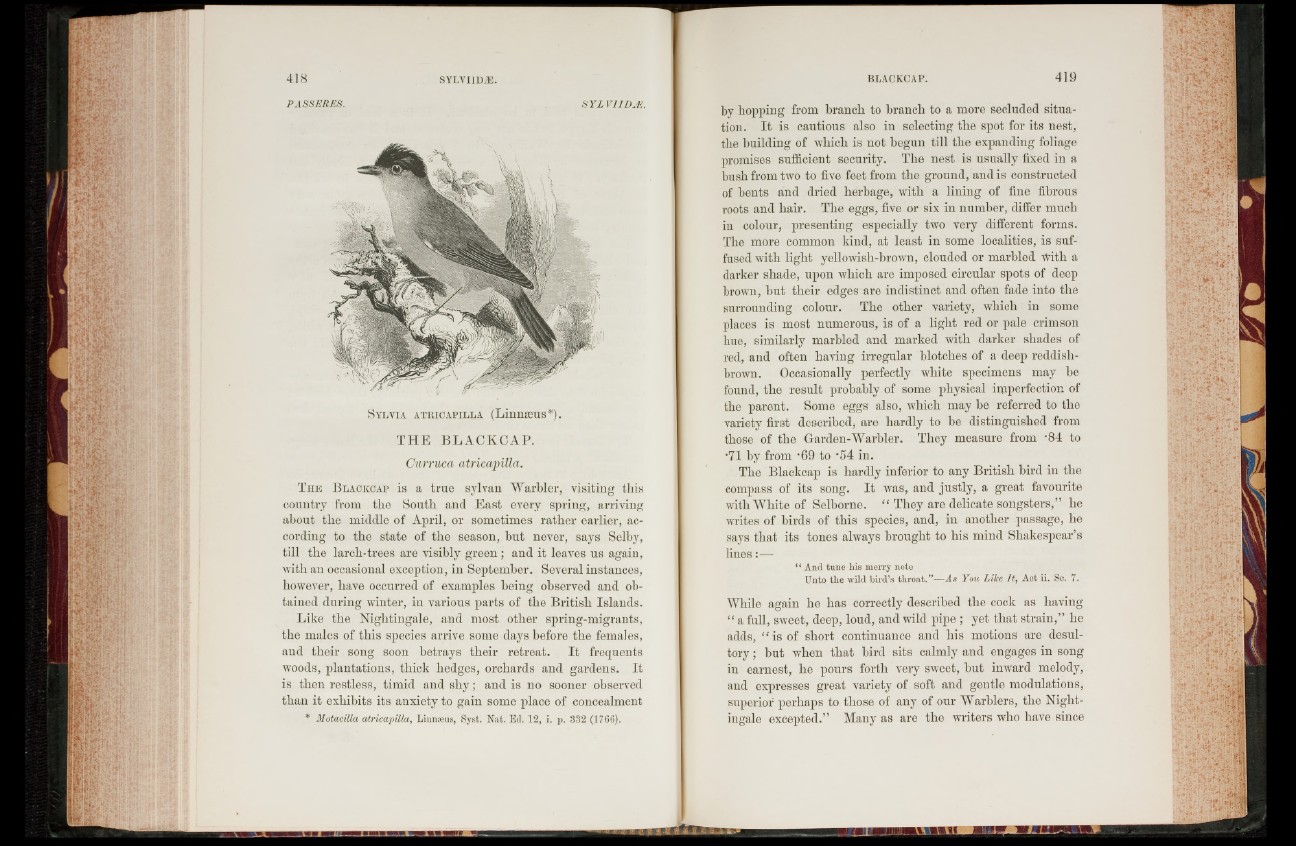
S y lv ia a t r ic a p il l a (Linnaeus*).
T H E BLACKCAP.
Curruca atricapilla.
T h e B la ck ca p is a true sylvan Warbler, visiting tliis
country from the South anti East every spring, arriving
about the middle of April, or sometimes rather earlier, according
to the state of the season, but never, says Selby,
till the larcli-trees are visibly green; and it leaves us again,
with an occasional exception, in September. Several instances,
however, have occurred of examples heing observed and obtained
during winter, in various parts of the British Islands.
Like the Nightingale, and most other spring-migrants,
the males of this species arrive some days before the females,
and their song soon betrays their retreat. I t frequents
woods, plantations, thick hedges, orchards and gardens. It
is then restless, timid and sh y ; and is no sooner observed
than it exhibits its anxiety to gain some place of concealment
* Motacilla atricapilla, Linnteus, Syst. Nat. Ed. 12, i. p. 332 (1768).
by hopping from branch to branch to a more secluded situation.
I t is cautious also in selecting the spot for its nest,
the building of which is not begun till the expanding foliage
promises sufficient security. The nest is usually fixed in a
bush from two to five feet from the ground, and is constructed
of bents and dried herbage, with a lining of fine fibrous
roots and hair. The eggs, five or six in number, differ much
in colour, presenting especially two very different forms.
The more common kind, at least in some localities, is suffused
with light yellowish-brown, clouded or marbled With a
darker shade, upon which are imposed circular spots of deep
brown, but their edges are indistinct and often fade into the
surrounding colour. The other variety, which in some
places is most numerous, is of a light red or pale crimson
hue, similarly marbled and marked with darker shades of
red, and often having irregular blotches of a deep reddish-
brown. Occasionally perfectly white specimens may be
found, the result probably of some physical imperfection of
the parent. Some eggs also, which may be referred to the
variety first described, are hardly to be distinguished from
those of the Garden-Warbler. They measure from -84 to
•71 by from ‘69 to '54 in.
The Blackcap is hardly inferior to any British bird in the
compass of its song. I t was, and justly, a great favourite
with White of Selborne. “ They are delicate songsters,” he
writes of birds of this species, and, in another passage, he
says that its tones always brought to his mind Shakespear’s
lines:—
“ Ancl tune his merry note
Unto the wild bird’s throat.”—As You Lilce It, Act ii. Sc. 7.
While again he has correctly described the cock as having
“ a full, sweet, deep, loud, and wild pipe ; yet that strain,” he
adds, “ is of short continuance and his motions are desultory
; but when that bird sits calmly and engages in song
in earnest, he pours forth very sweet, but inward melody,
and expresses great variety of soft and gentle modulations,
superior perhaps to those of any of our Warblers, the Nightingale
excepted.” Many as are the writers who have since